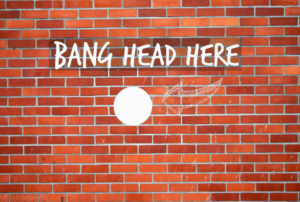Have you hit a frustrating training plateau?
You hit the gym diligently, day after day, week after week, and put in the work… but you just can’t PR your lifts. You’re frustrated as heck and ready to give in, right? Don’t.
They say the definition of insanity is doing the same thing, over and over again, while expecting a different result.
If you’ve plateaued your squat, deadlift, press, or any other lift, but continue to grind through the same programming without making any progress, you’re doing the gym equivalent of pounding your head into a wall.
Don’t worry, every athlete will run into a strength or performance plateau at some point in their journey.
By definition, a plateau means your body is no longer adapting to your training stimulus. And that means you need to step back and take a look at your program to decide what’s no longer working, then change it to stimulate new adaptation.
If you feel like you’ve hit a plateau, I can help you determine the cause and develop a customized training plan to attack your stalled lifts so you continue making progress in the gym. Apply for one-to-one coaching here.
If you’d rather trouble shoot on your own, this article is a good starting place.
There are a number of possible culprits for why you just can’t seem to add any weight to the bar despite your best efforts. The good news is, there are a ton of solutions to get yourself un-stuck, too. Let’s dive in.
Fix Your Form
Every flaw in your technique is shaving pounds from your PR and putting you at risk for training injuries. Fixing your form can make a heavy bar feel lighter almost instantly.
Think of your body as a plumbing or air conditioning system for a second. If you’re pumping water through your house, but there’s a leaky pipe, you’re wasting your time by increasing the water flowing through the system. You’re just going to end up with a bigger puddle. Likewise if you crank up the A/C in the summer while leaving your windows open. But, if you fix the leak or close the windows, the water and cool air go where they’re supposed to.
That’s exactly how poor technique affects your lifts – by allowing energy to “leak” to places it’s not needed or wanted.
Mobility
Sometimes, mobility restrictions make it harder to get into the proper positions for each lift. Make sure you’re warming up properly and including drills to address your personal mobility deficits.
Common mobility and technique issues include:
- Limited ankle dorsiflexion (shin toward foot)
- Unstable knees caving in during a squat
- Poor hip flexion restricting your squat depth
- Inability to hit full hip extension and lockout your deadlift
- Locked up thoracic spine preventing smooth shoulder motion during pressing
- Tight chest and rounded shoulders causing shoulder impingement on bench press
Before you can load a heavy barbell, you must address these mobility issues. Failure to do so will only lead to frustration and injury. Mobility doesn’t just mean stretching, though. Yes, you should increase your available range of motion (ROM). But you must also increase your ability to control that range of motion.
End-ROM is where injury is most likely to occur, so when we reach that end range, our bodies send out warning signals as a defense mechanism. Improving your motor control at end ranges will shut off those warning signals so that you can safely move heavier weights through a full range of motion.
A thorough dynamic warm up can help improve your range of motion. Learn my preferred warm-up strategy here.
Joint position
According to the joint-by-joint theory popularized by Grey Cook, some joints are meant to be mobile, while others are meant to be stable. This follows an every-other pattern: the ankle is mobile, the knee is stable, the hip is mobile, and so on through your lumber/thoracic spine and upper extremities.
When squatting and lunging, you want your knees to track in line with your big or second toe, which should result in pressing your knees out toward the sides of the squat rack, thus activating your glutes and creating a more powerful drive out of the bottom position.
When deadlifting, you also want to drive your knees out and externally rotate your hips to activate your glutes and lock out your deadlift. Think of screwing your feet into the ground to achieve this.
In Olympic lifts and their variations, “knees out” is also an important cue. Anecdotally speaking, push presses feel lighter when I’m able to get me knees out; mechanically speaking, that’s because I’m able to generate more power through my glutes and hips to move the bar faster so that all my arms have to do is lock out the lift.
Bottom line, your knee position can make a big difference on lower body strength exercises, cleans, push presses, jerks, snatches, and even kettlebell work.
Likewise, your upper body positioning makes a big difference on presses, chin ups, and rows. One of the most helpful cues I use with my athletes is “tuck your elbows” on push ups and rows to put your shoulders in a better position.
Bar Path
I hope I’m not stating the obvious when I assert the shortest distance between two points is a straight line. A wonky bar path is another energy leak sabotaging your attempts at a heavier lift.
An easy solution: film yourself lifting. This is the best way to check your bar path, and any other issues with your form.
Core and Bracing
You need a strong core to move heavy weight – period. If your lifts have plateaued, or you notice that you’re cranking out ugly reps as you approach maximum weights, it could be because your core just can’t stabilize your body under that much weight.
Solution: train your abs to fire before you lift and learn to breathe/brace properly I love deadbug variations and the Paloff press for retraining athlete’s abs to fire.
Add direct ab work after most of your training sessions (3-5 times per week) and make sure you train every abdominal function from flexion/extension to rotation and anti-movements throughout the week.
Muscle Activation
If the prime movers for a particular exercise are weak, other muscles will take over and try to get the job done. Using the bench press for example, your chest is the prime mover, while your shoulders and triceps help out. But if you have a weak chest, your other muscles will have to do more work to complete the bench press. Those muscles aren’t meant to shoulder the burden (bad pun intended). Isolating your chest with flyes and squeeze presses, for instance, will increase your strength and allow the prime mover muscle to do the job it’s meant to do.
Another example that affects nearly every lift is glute activation. Your glutes are the most powerful muscle in your body. They should be doing the majority of the work when it comes to heavy compound movements like squats, deadlifts, cleans, and even presses.
If you feel squats and lunges mostly in your quads, your glutes may not be firing effectively. Remedy this with glute activation drills like mini-band lateral walks and banded glute bridges.
You can also add accessory lifts like barbell hip thrusts, band or cable pull throughs, back extensions, and glute-ham raises to your program to build strength in your posterior chain. Engaging your butt during any lift will make it a stronger lift. Every. Damn. Time.
Adjust Your Program
First of all, you shouldn’t be jumping from program to program; give your program time to work before you change things up. Even then, small tweaks can make a big difference. Don’t change everything at once.
A good program will have you training with a variety of set, rep, and loading schemes to ensure progressive overload. Some of the most popular strength programs in the world use 3-5 sets of 3-8 reps at gradually ascending weights to build a solid foundation. That’s your wheelhouse – live within the 3-5 by 3-8 rep range. Add accessory work as needed at higher rep ranges to fortify your main lifts.
Try Harder
Most people who aren’t professional athletes (so, “most people”) have a hard time gauging their true max or pushing themselves outside of their comfort zones. Maybe you just need to dial up the intensity of your workouts for a while. If you were accustomed to fast progress when you started lifting, but progress has stalled, that’s natural. You might just need to grind through it.
Occasionally, you’ll have to shake up your training, especially if you’ve hit a true strength plateau. Use intensification techniques like ramping sets, wave loading, high-rep finishers, or drop sets to break through the plateau.
Ramping sets
Start with a light-to-moderate weight and squat for higher reps (8-10), then gradually increase the weight as you decrease the reps and build toward your working sets.
Example: 10x 95, 8x 125, 6x 145, 4×165, building to 3 sets of 3 at 185 (or whatever 85-90% of your 1RM may be).
Wave loading
Similar to ramping sets, but you’ll go up and down the “wave.” Do your first set at a moderate weight, increasing weights while doing fewer reps on a second and third set. Then, repeat those three sets, but at a heavier weight. It looks like this: 6x 115, 4x 135, 2x 155, 6x 135, 4x 155, 2x 175. You can add a third wave, but we warned, this is a lot of volume.
High-rep finishers
Exactly how it sounds. After your working sets, lighten the load slightly and perform a set of 8+ reps. This enters into the “strength-endurance” rep realm, which will improve your ability to work under fatigue.
Drop sets
Similar to high-rep sets, but meaner. After your last set of squats, do as many reps possible with the weight you’ve built up to, then drop 25% of the weight from the bar and rep out again until technical failure; optionally, strip another 10-20% of the weight off the bar and knock out a couple more reps.
Note: all of these techniques drastically increase your training volume, so don’t try them all at once. Pick one and stick with it for a couple weeks, or rotate through each of the techniques above once a week. That’s all you’ll need.
Train More Frequently
If you want to get better at deadlifting, you have to deadlift. Increasing your training frequency on a stalled lift means more practice and more progress. If you’re only deadlifting (or squatting or whatever) once per week, start deadlifting twice per week.
I recommend using different set, rep, and loading schemes on the two training days. The first time you attack the lift, train for pure strength in the 3-5 rep range; later in the week, train for strength-hypertrophy at slightly higher reps, or use speed deadlifts, block pulls, or deficit deadlifts to vary the training stimulus.
The only time increased training frequency is a bad idea is if you think your plateau has been caused by overtraining or lack of recovery. In that case, you’ll need to optimize recovery outside of the gym before ramping up your training.
Optimize Your Recovery
We sometimes overlook the fact that our bodies don’t get stronger in the gym. Rather, you become stronger during recovery. This includes everything from what you eat immediately after your workout, what you eat throughout the rest of the day and week, how much water you drink, how much sleep you get, your soft tissue and stretching routine, and what you do to manage life stress.
If any one of those factors is out of whack, you’ll never bust through your strength plateau by sheer force of will. Optimize your recovery by tracking what you eat, making sure to get enough calories and macronutrients to fuel your training; drinking at least half your bodyweight in ounces of water each day; and sleeping 7-9 hours each night, more after hard training days.
Another great strategy is foam rolling after your workout or before bed to decrease muscle tension and turn on your parasympathetic nervous system. That’s the part of your brain responsible for “rest and digest” mode, the opposite of the “fight or flight” instinct that keeps you wired in stressful situations.
If it’s within your budget, I also highly recommend setting up regular chiropractic adjustments or massage appointments. These body work services will keep your joints and muscles in top condition so you can push yourself harder in the gym on your strength building quest.
Take Control of Your Mindset
Maybe you freak out a little bit when you add up the weight on the bar and realize that it’s close to your max. Images of the bar flattening you to the floor may flash through your mind. If that’s the case, you’re not alone. It happens to the best of us.
The good news is, I’ve got proven solutions to prove to yourself that you can, in fact, lift the heavy weights you want to lift.
These are the non-sexy tips that will make a huge difference on your quest to demolish your strength plateau.
Get Comfortable With The Uncomfortable
 I’m not talking about “mind over matter” Jedi-mind tricks here, but rather getting comfortable with weights above your current max.
I’m not talking about “mind over matter” Jedi-mind tricks here, but rather getting comfortable with weights above your current max.
One way to do this with squats is to practice walking out the bar at +100% of your current 1RM.
That’s all you have to do – load up the bar with your current 1RM, take a big, deep belly breath to brace your core, tell yourself “I’ve got this,” and unrack the bar. Take 1-2 steps back and breath two deep breathes while remaining braced. Walk the bar back into the rack and rest.
That was the easy part. You already knew you could squat that weight.
Now, add 5-10# to the bar and repeat the procedure above. Try this a couple times with increasingly heavy weight (but only as you’re comfortable). Teaching your body to breath and brace with that weight on your back will help you overcome the mental block you might have toward squatting heavier weights.
You can use this technique on bench and overhead presses as well. Have a spotter on the bench, and play around with unracking and reracking the bar. For overhead presses, set the J-hooks to the point just below you’d lock out the lift and unrack the bar as you would a squat – bend your knees, grasp the bar overhead, and stand tall.
(Note: let’s be smart about this. You’re holding a lot of weight over your head. Use a spotter or set the pins up high to protect yourself if you have to bail.)
Stack “Small Wins”
When you hit a training plateau, it can be frustrating as hell to feel stuck lifting a certain weight workout after workout. That’s where the idea of small wins can be a game changer. Track your workouts meticulously – sets, reps, weights, tempo, rest periods, how the lift felt subjectively – everything. Aim to improve just one category.
For instance, maybe your bench press is stuck at 145 pounds for 5 reps. You can’t go up to 150# even for a single, and you can’t finish a sixth rep with 145. Next time you bench, add an extra set at your current max weight. That’s 5×145 more weight lifted – 725# is nothing to scoff at!
Strive to hit a “technical PR” instead of a heavier weight. That means knocking out all your reps with perfect technique. Again, with bench press, if your elbows always flair out, focus all your mental energy on better elbow position. Complete an entire set with better position, that’s a small win.
Note these things, no matter how small and insignificant they seem, in your training log.
Seeing the small wins stack up will prove to your inner critic that you are, in fact, making progress, and this will motivate you to accumulate more wins until you bust through your plateau.
Enlist Expert Help
Sometimes you just need to get a third party to look at your lifts, your technique, or your program and point out the problems that you can’t see because you’re too close to it.
That could mean getting a friend to be your training buddy. You’ll be able to push yourself harder with friendly competition. A stupid-simple way to check on your technique is to film yourself lifting. Just as athletes watch game footage, you’ll be able to watch your lifts and look for areas you can improve.
If that doesn’t help, hire a coach. A good coach can spot flaws in your technique and design a program to overcome your weaknesses. They can help you troubleshoot any issues that come up in your training and keep you on track.
If you’re frustrated with your lack of progress in the gym, apply for one-to-one coaching with KPxFitness. We’ll do a program audit to figure out what’s holding you back and design a customized training plan. You’ll get access to expert coaching and a plan to attack your weak points so that you finally bust through your strength plateau!


